Review: HTC One A9 for AT&T
Lock Screen
The One A9 may be among the first handsets to run Android Marshmallow 6.0, but the phone uses the same Sense lock screen that's found on older HTC smartphones. The one major difference is, of course, the fingerprint reader.
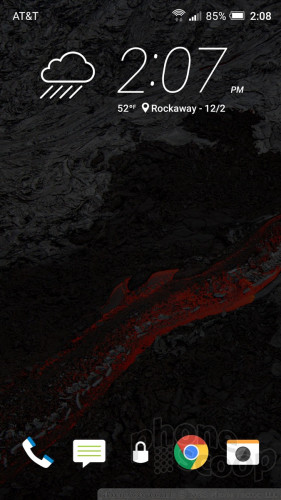
Users can select from several different lock screen behaviors. Most show the clock, notifications, and shortcuts when the screen lock button is pressed.
The A9's fingerprint sensor works in coordination with the PIN, pattern, or alpha-numeric password. Basically, you set one of those three to lock the phone, but your thumbprint can serve as an alternate way to unlock the A9. I was able to train four fingerprints and found the A9 to be reasonably good at recognizing prints quickly on the first attempt. The Nexus 6P, iPhone 6s, and Galaxy S6/Note 5 are all a bit faster, the but A9's fingerprint reader is fast enough that I found it more convenient than a regular password.
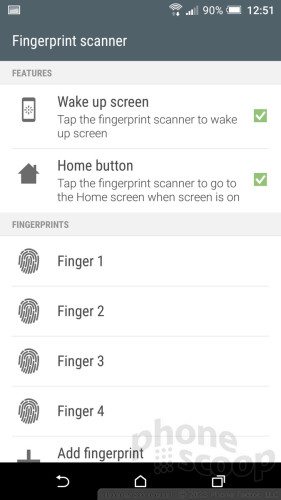
Home Screens
The One A9 runs Android 6.0 (Marshmallow) with the latest version of HTC Sense software on top. HTC dialed Sense back a bit this time around. For example, HTC ditched its notification shade for the stock Quick Settings panel. It's also using more of the stock Android apps (Gmail, music) rather than its own. Sense has its own fonts, icons, graphics, and settings tools. It offers a rich set of personalization features, but it isn't for everyone.
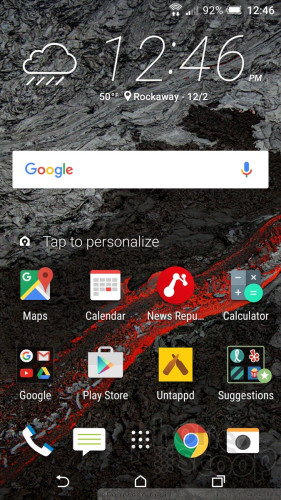
The home screen panels and notification shade work pretty much the same as they do on all Android handsets. HTC's app menu offers a lot more flexibility than the stock Android version, as it allows users to arrange apps alphabetically, in a custom configuration, or via most-recently-used. It also lets people change the size of the grid, as well as hide and otherwise manage apps by stuffing them into folders.
The One A9 includes HTC's included BlinkFeed social news reader app, which is, by default, the left-most homescreen panel. BlinkFeed is sort of like Flipboard and lets you package inbound news stories into a single, socially-connected reader. You can disable it if you want.
Customizing the home screen appearance is a key trait of Sense, and that's no different on the One A9. Users can change the bottom navigation buttons, select from a handful of pre-installed themes, and then tweak each theme with various accent colors, wallpapers, keyboards, fonts/sizes, and on and on.
(To be frank, I ditched Sense for the Google Now launcher, which is the same one used by Google's Nexus-branded phones. I'd rather have Google Now as the left-most screen than BlinkFeed.)
Whichever home screen configuration you choose, the A9 supports Google Now On Tap. With Now On Tap, a long press of the home button delivers contextually-relevant details about whatever is on the screen. As I said in my review of Android 6.0 Marshmallow, Now On Tap is best used when emails or text message threads include references to restaurants, bars, clubs, movies, and the like.
I was worried about the processor headed into this review, but, like the battery, my worries were unfounded. The A9 packs a 1.5 GHz Qualcomm Snapdragon 617. While it's not an 800-class processor, it's still a solid chip that, when paired with 3GB of RAM, delivered the goods. The A9 never felt slow or underpowered, and was always quick to open apps and complete tasks.
Camera
The One A9's camera app is more a less an exact replica of the One M9's camera app. You can open the app from the lock screen, but there is no dedicated camera button.
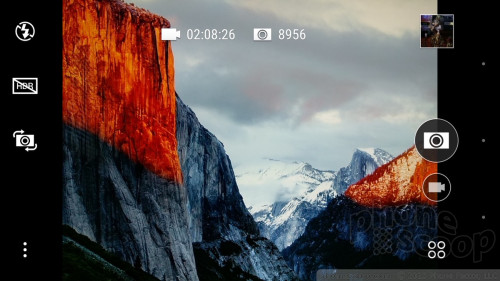
The basic viewfinder includes separate shutter buttons for the camera and video camera, a button to switch between the different shooting modes, and access to the gallery. The camera also has toggles for the flash and HDR, and a simple settings tool.
The A9 ships with six main shooting modes: normal, selfie, panorama, pro, hyperlapse, and slow motion. These are all self-explanatory and behave as expected. In addition to the dedicated camera mode switcher, you can jump between the modes quickly by swiping your finger up or down on the screen, similar to the One M9. You cannot download and install other shooting modes, however, nor can you create your own custom modes. That's a bit of a bummer.
Most people will be pleased if they stick to the normal shooting mode, but the pro mode makes a wide set of tools available for creative image capturing. For example, the normal mode does not let users adjust white balance, ISO, shutter speed, or focus, but the pro mode does. Pro mode lets you take exposures up to 2 seconds, which can make for some fun night-time shots. Moreover, the pro mode captures images in RAW format, which allows for more advanced editing after the fact.
Scenes — such as macro, landscape, and night shot — are gone entirely, but the selfie mode includes HTC's software-controlled beautification tool. The Zoe capture tool, which snags a video snippet and several images at the same time, is available but only when using the camera cropped down to 10 megapixels (16:9). It's not easy to find, but the results are the same as ever.
The camera app offers a nice balance of features and is quick to open and shoot photos.
Photos/Video
The One A9's main sensor captures 13 megapixels in the 4:3 aspect ratio or 10 megapixels in the 12:9 aspect ratio. Either way, the images were surprisingly good. In fact, I think they look better than similar shots captured with the One M9. The pictures were generally sharp, and nearly always had accurate exposure and white balance. Low-light shots were a touch on the grainy side, but not overly so. I am pleased enough with the photos that I'd say you use the A9 for everyday photo needs and more important events.
The selfie cam can snag 4-megapixel images. I'd call the results decent, and much improved over what I saw from the One M9. Most importantly, low-light images weren't a complete disaster; instead, they had only a small amount of grain and were often in focus and accurately exposed.
The A9 records video at a max. resolution of 1080p HD. (No 4K for you.) The 1080p video I captured looked fine. Focus, exposure, and color were spot-on the majority of the time. You can use the One A9 for your everyday video needs and beyond.
AT&T/HTC Stuff
The usual amount of bloatware from AT&T is preinstalled, but the One A9 lets you delete or hide most of it. Thank goodness.
HTC's most interesting app is the Zoe app for piecing together photos/videos into shareable montages. It's a fun tool that works well. The fx photo editor is another powerful app for fine-tuning your pictures. It works especially well with images captured in RAW mode.


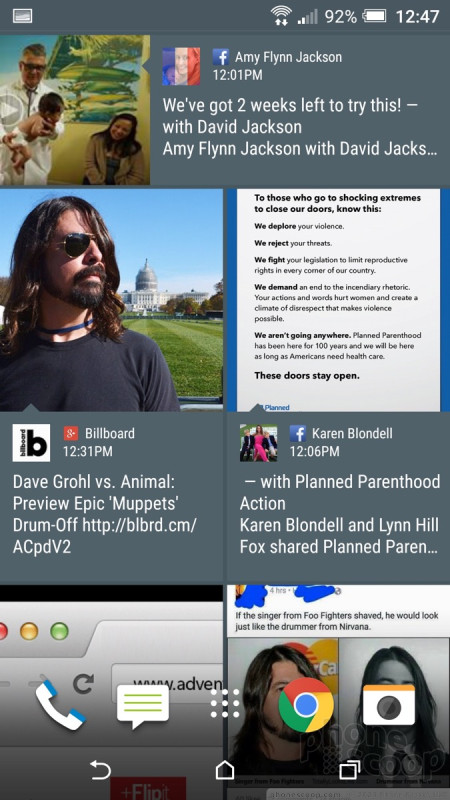








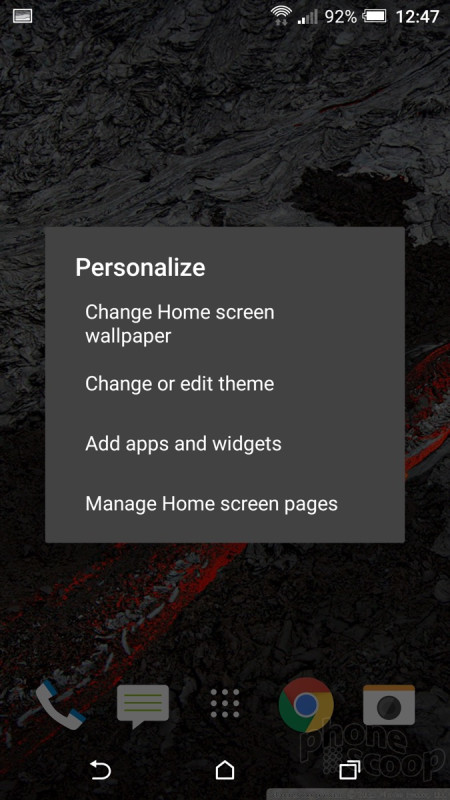





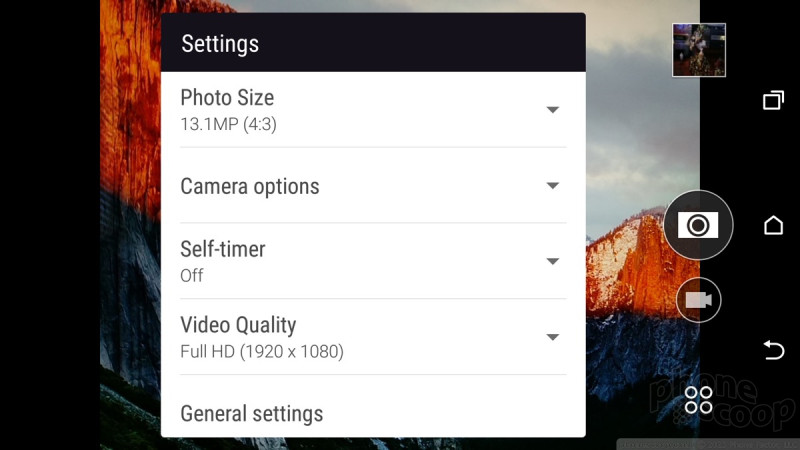
















 Hands On with the HTC One A9
Hands On with the HTC One A9
 HTC's One A9 Boasts Fingerprint Reader and Runs Marshmallow
HTC's One A9 Boasts Fingerprint Reader and Runs Marshmallow
 HTC One A9: First Phone To Work on Verizon Without CDMA
HTC One A9: First Phone To Work on Verizon Without CDMA
 HTC One A9
HTC One A9




